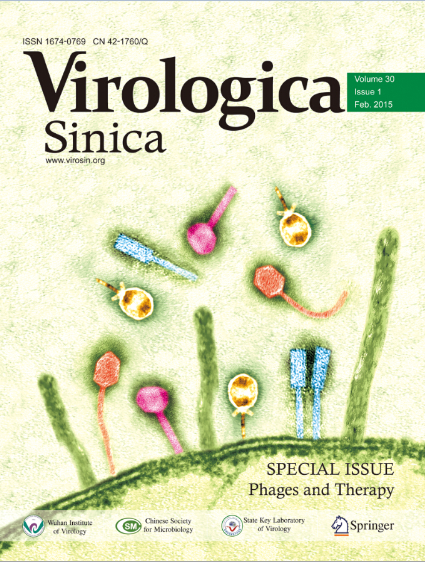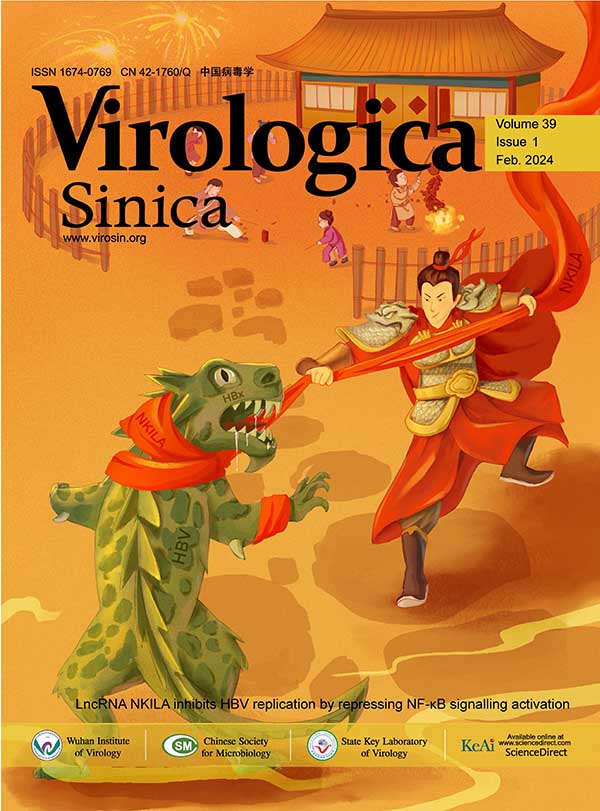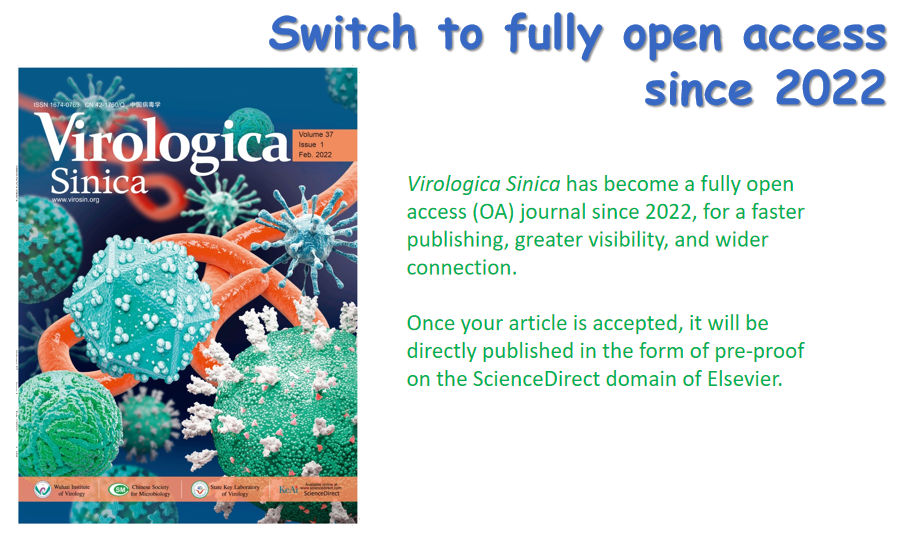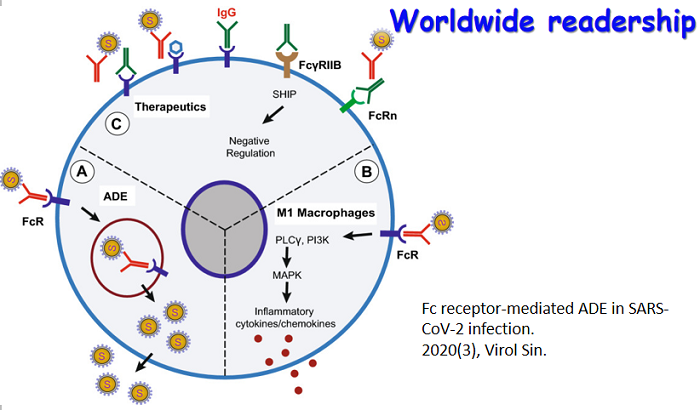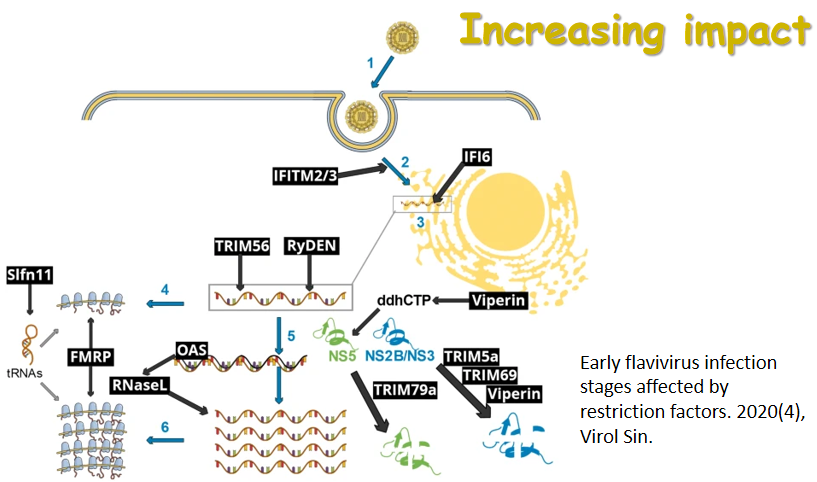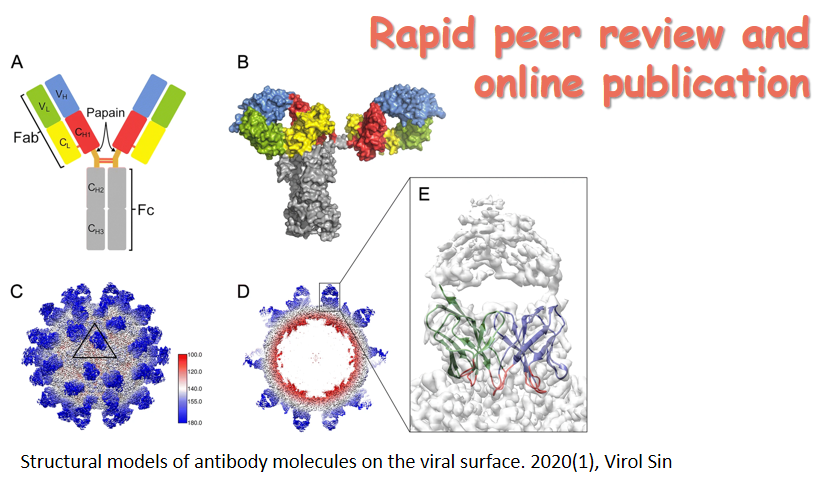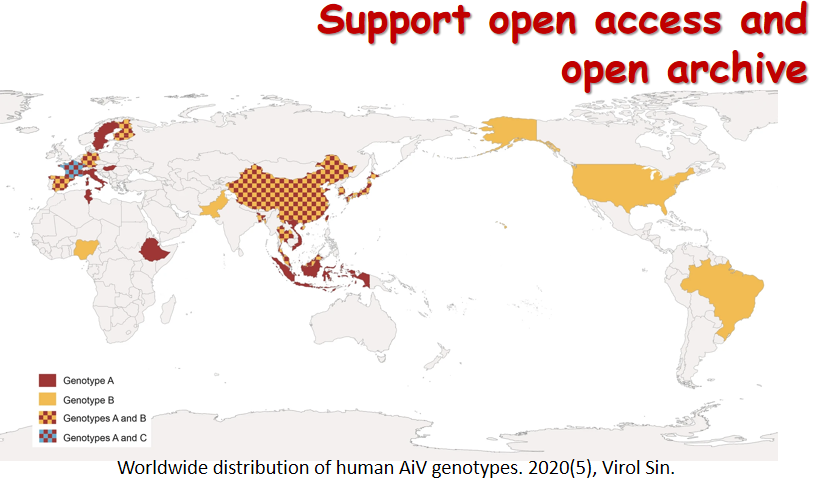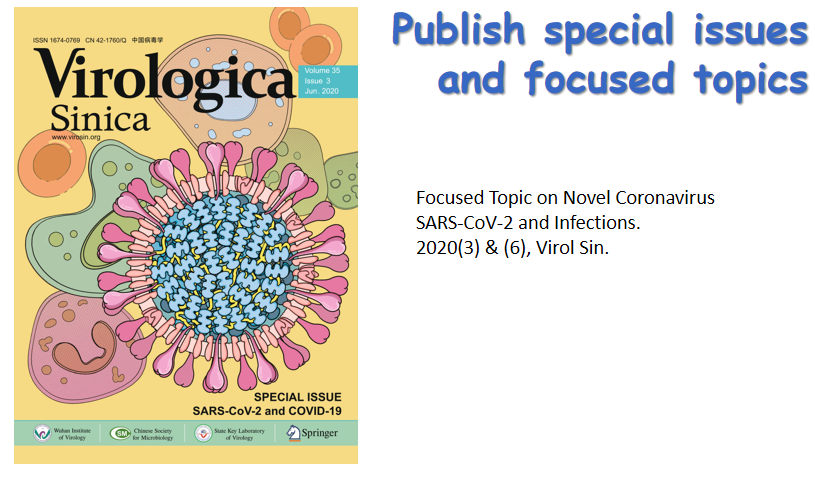This issue of Virologica Sinica is to celebrate the 100th anniversary of the discovery of “fi lterable lytic factor” or “bacteriophage” (1915-2015). During the past 100 years, both basic knowledge and applications of bacteriophages have been substantially explored and developed. In recent years, bacteriophage research is booming and holding the hope to tackle the rise of antimicrobial resistance in the post-antibiotic era. In this issue, new phages are introduced, phage lytic enzymes are described, phage and host interactions are discussed, and successful experiences of phage therapy are shared. The cover illustrates the phages in this issue: ΦVMY22 (golden yellow), ΦCASbig (orange red), ΦKAZ14(magenta). And the phage in blue color is the courtesy of the Core Facility of Wuhan Institute of Virology.
-

Experience of the Eliava Institute in bacteriophage therapy
2015, 30(1): 80 doi: 10.1007/s12250-014-3557-0
出版日期: 2015-02-05 -
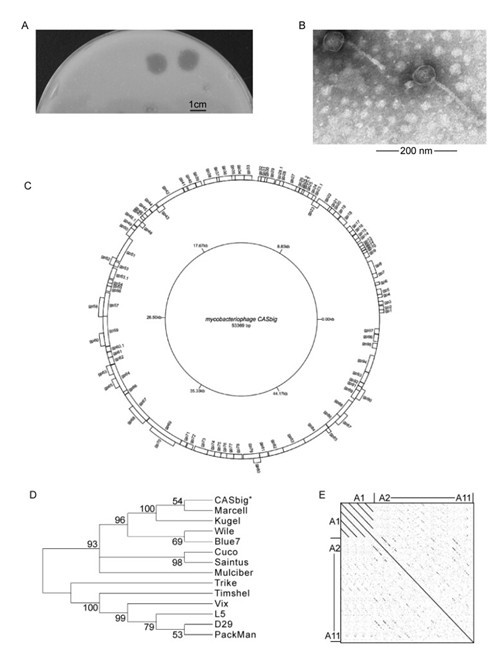
-
-
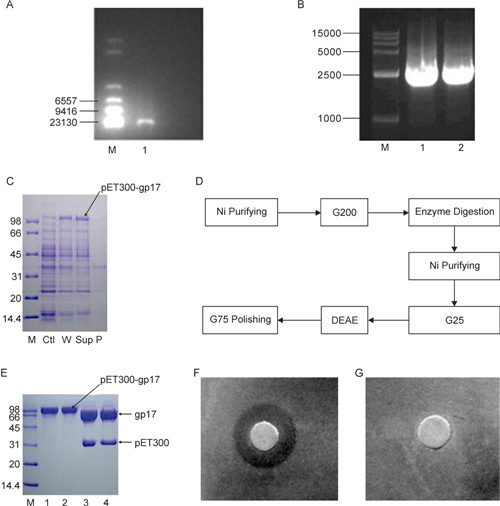
-
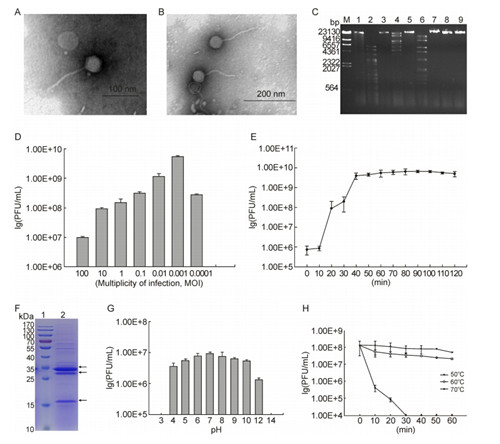
-
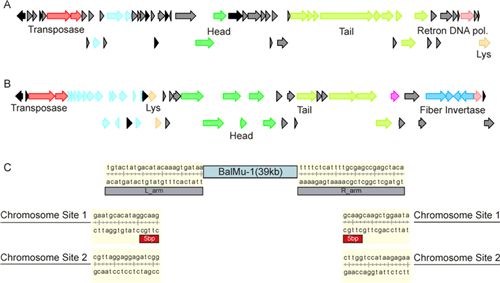
从嗜碱芽胞杆菌Bacillus alcalophilus CGMCC 1.3604 (ATCC 27647)中鉴定一种新的转座原噬菌体BalMu-1
2015, 30(1): 63 doi: 10.1007/s12250-014-3497-8
出版日期: 2015-01-22 -
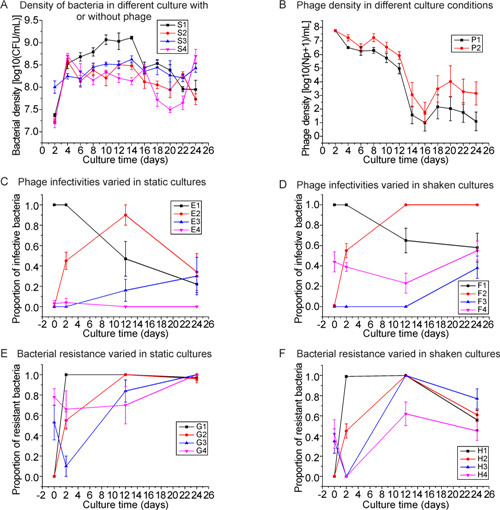
Pseudomonas fluorescens SBW25及其噬菌体bacteriophage Ф2之间相互作用的抗性与毒力变化以及噬菌体治疗思考
2015, 30(1): 59 doi: 10.1007/s12250-014-3490-2
出版日期: 2015-01-12 -
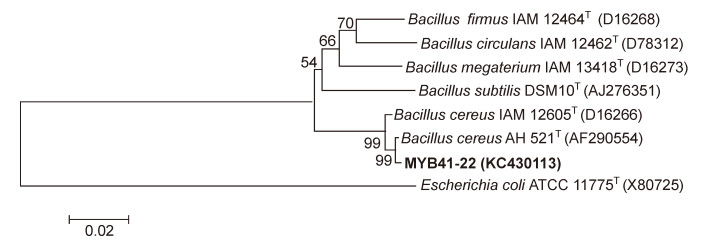
一株冰川蜡样芽孢杆菌低温噬菌体VMY22的分离及特性研究
2015, 30(1): 52 doi: 10.1007/s12250-014-3529-4
收稿日期: 2014-10-30 录用日期: 2015-01-21 出版日期: 2015-02-02As a unique ecological system with low temperature and low nutrient levels, glaciers are considered a “living fossil” for the research of evolution. In this work, a lytic cold-active bacteriophage designated VMY22 against Bacillus cereus MYB41-22 was isolated from Mingyong Glacier in China, and its characteristics were studied. Electron microscopy revealed that VMY22 has an icosahedral head (59.2 nm in length, 31.9 nm in width) and a tail (43.2 nm in length). Bacteriophage VMY22 was classifi ed as a Podoviridae with an approximate genome size of 18 to 20 kb. A one-step growth curve revealed that the latent and the burst periods were 70 and 70 min, respectively, with an average burst size of 78 bacteriophage particles per infected cell. The pH and thermal stability of bacteriophage VMY22 were also investigated. The maximum stability of the bacteriophage was observed to be at pH 8.0 and it was comparatively stable at pH 5.0-9.0. As VMY22 is a cold-active bacteriophage with low production temperature, its characterization and the relationship between MYB41-22 and Bacillus cereus bacteriophage deserve further study. -
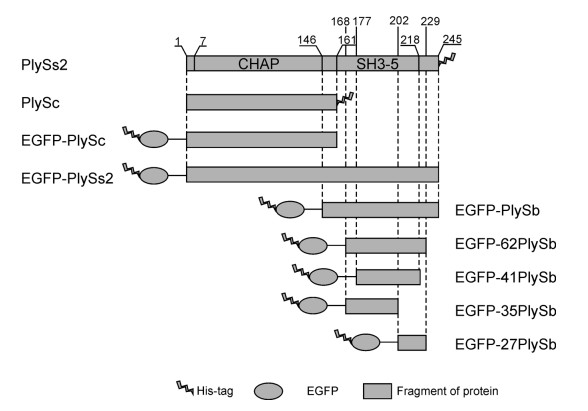
噬菌体裂解酶PlySs2的分子解析:催化域和细胞壁结合域的有机组合决定其广谱裂解活性
2015, 30(1): 45 doi: 10.1007/s12250-014-3535-6
收稿日期: 2014-11-09 录用日期: 2015-01-23 出版日期: 2015-02-04The novel phage lysin PlySs2, is reported to be highly active against various bacteria, including staphylococci, streptococci and Listeria. However, the molecular mechanisms underlying its broad lytic spectrum remain to be established. In the present study, the lytic activity of the catalytic domain (CD, PlySc) and binding specificity of the cell wall binding domain (CBD, PlySb) of PlySs2 were examined. Our results showed that PlySc alone maintains very limited lytic activity. Enhanced green fluorescent protein (EGFP)-fused PlySb displayed high binding affinity to the streptococcal strains tested, including S. suis, S. dysgalactiae, and S. agalactiae, but not staphylococci, supporting its utility as a good CBD donor for streptococcal-targeted lysin engineering. EGFP-fused intact PlySs2 similarly displayed high affinity for streptococci, but not staphylococci. Notably, four truncated PlySb fragments showed no binding capacity. These fi ndings collectively indicate that integrity of the PlySc and PlySb domains is an essential determinant of the broad lytic activity of PlySs2. -
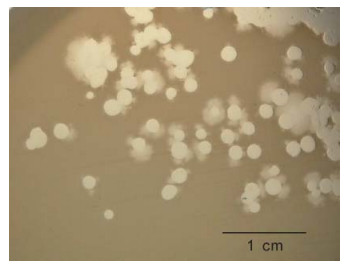
Selection of phages and conditions for the safe phage therapy against Pseudomonas aeruginosa infections
2015, 30(1): 33 doi: 10.1007/s12250-014-3546-3
收稿日期: 2014-11-15 录用日期: 2015-01-30 出版日期: 2015-02-05The emergence of multidrug-resistant bacterial pathogens forced us to consider the phage therapy as one of the possible alternative approaches to treatment. The purpose of this paper is to consider the conditions for the safe, long-term use of phage therapy against various infections caused by Pseudomonas aeruginosa. We describe the selection of the most suitable phages, their most effective combinations and some approaches for the rapid recognition of phages unsuitable for use in therapy. The benefi ts and disadvantages of the various different approaches to the preparation of phage mixtures are considered, together with the specifi c conditions that are required for the safe application of phage therapy in general hospitals and the possibilities for the development of personalized phage therapy. -

霍乱弧菌中溶原性噬菌体 CTXΦ的生存与扩散
2015, 30(1): 19 doi: 10.1007/s12250-014-3550-7
收稿日期: 2014-12-02 录用日期: 2015-01-12 出版日期: 2015-01-20The lysogenic phage CTXΦ of Vibrio cholerae can transfer the cholera toxin gene both horizontally (inter-strain) and vertically (cell proliferation). Due to its diversity in form and species, the complexity of regulatory mechanisms, and the important role of the infection mechanism in the production of new virulent strains of V. cholerae, the study of the lysogenic phage CTXΦ has attracted much attention. Based on the progress of current research, the genomic features and their arrangement, the host-dependent regulatory mechanisms of CTXΦ phage survival, proliferation and propagation were reviewed to further understand the phage's role in the evolutionary and epidemiological mechanisms of V. cholerae. -
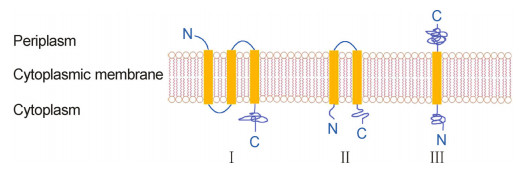
肠杆菌科细菌的噬菌体治疗
2015, 30(1): 11 doi: 10.1007/s12250-014-3543-6
收稿日期: 2014-11-13 录用日期: 2015-01-07 出版日期: 2015-02-03The Enterobacteriaceae are a class of gram-negative facultative anaerobic rods, which can cause a variety of diseases, such as bacteremia, septic arthritis, endocarditis, osteomyelitis, lower respiratory tract infections, skin and soft-tissue infections, urinary tract infections, intra-abdominal infections and ophthalmic infections, in humans, poultry, animals and fi sh. Disease caused by Enterobacteriaceae cause the deaths of millions of people every year, resulting in enormous economic loss. Drug treatment is a useful and effi cient way to control Enterobacteriaceae infections. However, with the abuse of antibiotics, drug resistance has been found in growing number of Enterobacteriaceae infections and, as such, there is an urgent need to find new methods of control. Bacteriophage therapy is an efficient alternative to antibiotics as it employs a different antibacterial mechanism. This paper summarizes the history of bacteriophage therapy, its bacterial lytic mechanisms, and the studies that have focused on Enterobacteriaceae and bacteriophage therapy. -
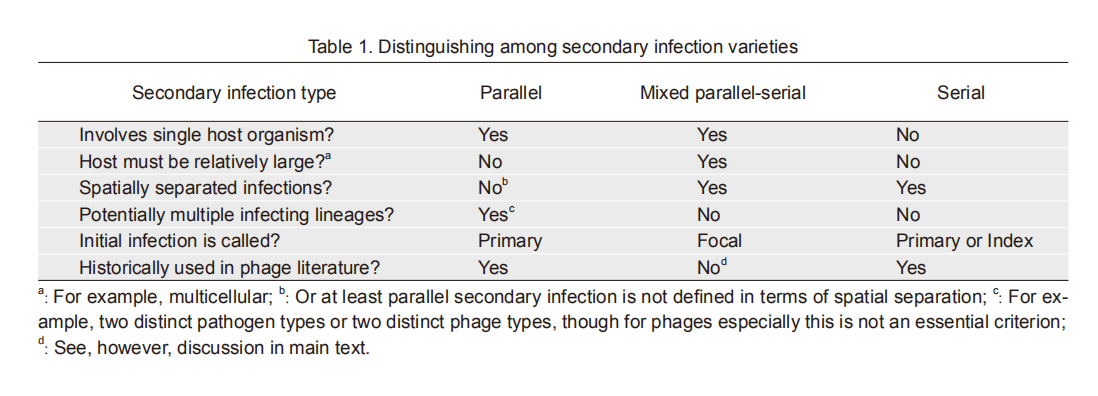
Bacteriophage secondary infection
2015, 30(1): 3 doi: 10.1007/s12250-014-3547-2
收稿日期: 2014-11-17 录用日期: 2014-12-29 出版日期: 2015-01-13Phages are credited with having been fi rst described in what we now, offi cially, are commemorating as the 100th. anniversary of their discovery. Those one-hundred years of phage history have not been lacking in excitement, controversy, and occasional convolution. One such complication is the concept of secondary infection, which can take on multiple forms with myriad consequences. The terms secondary infection and secondary adsorption, for example, can be used almost synonymously to describe virion interaction with already phage-infected bacteria, and which can result in what are described as superinfection exclusion or superinfection immunity. The phrase secondary infection also may be used equivalently to superinfection or coinfection, with each of these terms borrowed from medical microbiology, and can result in genetic exchange between phages, phage-on-phage parasitism, and various partial reductions in phage productivity that have been termed mutual exclusion, partial exclusion, or the depressor effect. Alternatively, and drawing from epidemiology, secondary infection has been used to describe phage population growth as that can occur during active phage therapy as well as upon phage contamination of industrial ferments. Here primary infections represent initial bacterial population exposure to phages while consequent phage replication can lead to additional, that is, secondary infections of what otherwise are not yet phage-infected bacteria. Here I explore the varying meanings and resultant ambiguity that has been associated with the term secondary infection. I suggest in particular that secondary infection, as distinctly different phenomena, can in multiple ways infl uence the success of phage-mediated biocontrol of bacteria, also known as, phage therapy. -
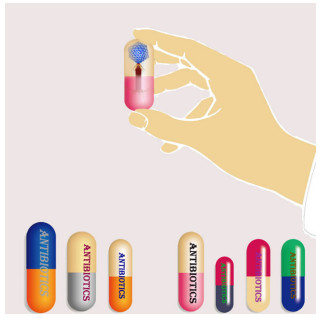
Bacteriophages, revitalized after 100 years in the shadow of antibiotics
2015, 30(1): 1 doi: 10.1007/s12250-014-3562-y
出版日期: 2015-02-05The year 2015 marks 100 years since Dr. Frederick Twort discovered the “filterable lytic factor”, which was later independently discovered and named “bacteriophage” by Dr.Felix d'Herelle. On this memorable centennial, it is exciting to see a special issue published by Virologica Sinica on Phages and Therapy. In this issue, readers will not only find that bacteriophage research is a booming field but also learn about the diverse applications currently being explored for bacteriophages. The biggest driving force behind these applications is the serious threat of bacterial antibiotic resistance that is emerging in the current era
- [01/11]《中国病毒学(英文)》期刊编辑部招聘启事
- [05/07]Q1区!VS最新影响因子5.5!
- [22/02]2022年VS高被引论文奖发布
- [21/10]第十届新生病毒性疾病控制学术研讨会 | 第一轮通知
- [09/09]肝癌细胞中CK1α上调IFNAR1的表达,从而促进I型IFN抑制HBV复制
- [09/09]一种新的干扰素诱导的长非编码RNA ZAP-IT1阻断寨卡病毒在A549细胞中的复制
- [09/09]首发精神分裂症中,驯化的人内源性逆转录病毒W家族包膜蛋白通过降低5-HT4受体的水平激活SK2
- [09/09]发热伴血小板减少综合征病毒L蛋白功能域和保守残基研究为理解病毒RNA转录/复制机制提供新思路
- [09/09]亲环素A结合AKT1并通过介导AKT/mTOR/NF-κB正反馈环路的激活促进EB病毒的致瘤作用 | VS推荐
- [09/09]转录组分析显示克里米亚刚果出血热病毒调控的关键细胞过程及III型干扰素的抗病毒作用 | VS推荐







